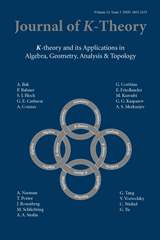Crossref Citations
This article has been cited by the following publications. This list is generated based on data provided by Crossref.
Wickelgren, Kirsten
2017.
Massey products 〈y,x,x,…,x,x,y〉 in Galois cohomology via rational points.
Journal of Pure and Applied Algebra,
Vol. 221,
Issue. 7,
p.
1845.


